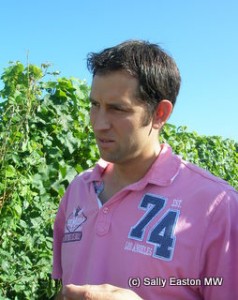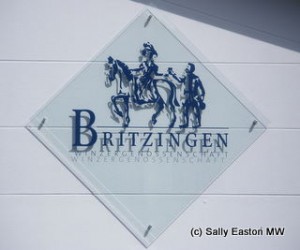Germany’s Burgundian links

Eric Manz
Riesling may be Germany’s signature grape variety, covering 20% of the country’s vineyard area, but another 10% is covered with the increasingly trendy grauburgunder (pinot gris/grigio) and weissburgunder (pinot blanc).
Plantings of these two increased by more than 50% during the first decade of the 21st century, which means that grauburgunder and weissburgunder now rank as the sixth and seventh, respectively, most planted grape varieties in Germany. Together with spätburgunder / pinot noir, this trio cover almost the same amount of vineyard area as riesling, making them a growing force on the German wine scene.
As plantings have increased, so wine styles have evolved, and both are now being drunk in oaked and unoaked styles. Eric Manz of Weingut Manz in Rheinhessen said “I used to make my top quality weissburgunder without oak until two years ago. Then the gastronomy sector asked for [an oaky style], and now I’m convinced this is the right way to do it.“
Further south in deepest Baden, Joachim Heger, owner of Weingut Heger, emphasised how “pinots do very well with food. Pinot gris is very popular in northern Germany, while in southern Germany people like pinot blanc at least as much as pinot gris.” Heger’s wines are all dry, which he says makes them more food-friendly than sweeter styles. More than half his total production is of grauburgunder and weissburgunder, and his top wines such as Achkarrer Schlossberg weissburgunder “is always fermented in barrel for more complexity” he said.
Oak doesn’t hold universal appeal though. Martin Messmer of the Messmer estate in the Pfalz is less keen, even for his top wines such is ‘Im Goldenen Jost’, which has 2% new barrique. He said “for me it is too much because the aromas are lost a little under the barrique.” All of which means the trend for pinot varieties creates an innovative flux among producers.
Along with some oak, the malolactic fermentation, often on a proportion of the fruit, provides additional texture in the more serious (expensive) styles. Manz said “malo helps to reduce the acidity, and to get better texture.” For Heger it’s more a vintage thing, he said, as “we did no malo at all in 2009, because the acidity was lower” in that very ripe year. Then in the more classic 2010 vintage, Heger used the malo in some of his wine.
 Barrels and malo add complexing textures and flavours into the wines. Grauburguner can take on an aromatic nutmeg and perfume spice. And weissburgunder heads towards a Burgundian style, with aromatic spices, fatness, texture and nutty notes to the wine.
Barrels and malo add complexing textures and flavours into the wines. Grauburguner can take on an aromatic nutmeg and perfume spice. And weissburgunder heads towards a Burgundian style, with aromatic spices, fatness, texture and nutty notes to the wine.
Experimentation in the winery is no surprise given that in their ‘pure’ state, neither grape variety is necessarily hugely aromatic, though both retain clean, fresh, lucid lines without oak influence. Weissburgunder tends to be a bit more full bodied than grauburgunder, and may also be a little more reticent on the nose, with delicate fresh, white nut notes amid white fruits such as apple and pear and white-fleshed nectarines, and sometimes a white pepper spice. Grauburgunder tends to be more appley, lemony and pear-ish with a moderate acidity.
Where these grapes converge is in their origins. All hail originally from Burgundy. Pinot blanc (weissburgunder) was first reported in the 19th century as a white mutation of pinot gris (grauburgunder). And pinot gris had already mutated from pinot noir. As apparent evidence for this, ripe grauburgunder has a shiny, muddy-mauve colour, and this explains why it’s possible to get a faint pink hue to a white wine made from it. But France no longer has primacy for grauburgunder. Germany’s plantings of this variety are the third largest in the world, after Italy (under its pinot grigio moniker) and the USA.
Also deriving from their Burgundian origins, the pinot varieties do very well on loess and limestone soils, thus most grauburgunder and weissburgunder is grown in Baden, Pfalz and Rheinhessen. These regions run in a north-south direction along one or other side of the Rhine river, south of Mainz. Manz, in Rheinhessen, said “loess, which covers most of the Rheinhessen region, is a good soil for pinot blanc. And below the loess is limestone, which is an ideal soil for the pinots because the vines have to send roots deep, which is better to get minerality” in the wines. And Messmer in the Pfalz, added his pinot varieties are “all on limestone because it makes them smooth, and they don’t have a high acidity coming from the warm soil, which gives more physiological ripeness.”
Tasting notes, in situ, August 2011
Weingut Manz, Grauer Burgunder Trocken, Alte Reben, 2010, Rheinhessen €9
13%. Creamy nose, supple attack, white pepper piquancy with a bit of firestone, nice depth and freshness of primary fruit, with that fresh-creamy texture. Good.
Weingut Messmer, Grauburgunder 2010, Kabinett Trocken, Pfalz €7.80
12.5%. Fresh, creamy, lifted piquancy of acidity, then smooth, creamy with hint of white pepper. Silky smooth. Very nice.
Britzinger, Grauer Burgunder 2010, Kabinett Trocken, Baden €5.95
Yellow/green hue. Fresh-cream, white nuts, light and appealing aperitif, balanced and refreshing. Good.
Britzinger, Sonnhole SONNE, Grauer Burgunder Spatlese Trocken 2009, Baden €7.95
14%. Smooth and silky white-creamed nuts, aromatic spice notes, nicely integrated and balanced. Fresh enough with medium weight of body and decent substance. Good.
Dr. Heger, Ihringer Winklerberg, Grauburgunder Spatlese Trocken 2010, Baden €16.50
His ‘basic’ pinot gris/gio, 13%, White peach and pear. Fresh and smooth. Light and intense, with hints of freshly-harvested cob nuts. This is really posh, and tasty ‘pinot grigio’. Good.
Weingut Bercher, Grauer Burgunder Burkheimer Schlossgarten, Kabinett Trocken 2010, Baden €8.50.
Creamy, white nuts, fresh and straight down some very nice lines. Good aperitif, nice to drink, with juicy acidity and white fruit on the finish.
Weingut Bercher, Grauer Burgunder Spätlese Trocken 2009, Burkheimer Feuerberg, Baden
13%. Rich, lush-dry combo, dry tropical fruits, steely edge running through its linear structure and definition. Ripe and tropical, with chalk-stony edge to it. Good.
Weingut Klumpp, Grauburgunder Alte Reben 2010, Baden
13.5% White stone fruits on nose, fresh, creamy white nuts as palate attack. Nice, slippery-smooth texture. Fresh balance with white pepper and sweet spice finish. Good.
Weingut Manz, Weisser Burgunder Trocken, Loess, 2010, Rheinhessen €6
Gentle, white pear, white pepper spice on mid palate. Nice freshness and tastiness. Good flavour in mouth, though not especially long.
Weingut Messmer, Weissburgunder, Im Goldenen Jost, 2008 GG, Pfalz €19
Hints of gunsmoke, and creamed fresh cob nuts. Supple and silky texture, rich and pepper-spicy. Very good.
Dr. Heger, Ihringer Winklerberg, Weissburgunder Spatlese Trocken, 2010, Baden
13%. The ‘basic’ pinot blanc. Citrus, smooth, white fresh-cream, balanced with poise. Good.
Dr. Heger, Ihringer Winkerlberg, Weissburgunder ***, Grosses Gewaches trocken, Gras im Ofen 2010, Baden €20.50
Chalky, floral nose in fully dry wine with hints of white pepper spice and allspice in white fresh-cream. Pristine and very clean, with a really big intensity. Vg
Dr. Heger, Achkarrer Schlossberg, Wesibburgunder *** GG trocken 2010, Baden
Aromatically spicy, creamy-fresh-cream. Fresh-fat, spicy and peach. Vg
Weingut Bercher, Weissburgunder Spatlese Trocken, Sasbacher Limburg 2010, Baden
Rich, fat, spicy, tropical nose. Then sweet-fruited, yellow stones, in supple and smooth textured body. Tasty wine that finishes fresh and light.
Weingut Klumpp, Kirchberg Weissburgunder 2010, Baden
13.5%. Firestone and tropical fruit, sweet fruit attack in a medium body. Nice bit of intensity and palate prickle, with nutmeg and pineapple. Fresh, sweet finish of a dry wine. Vg.
My research trip was sponsored by Deutsches Weininstitut.



